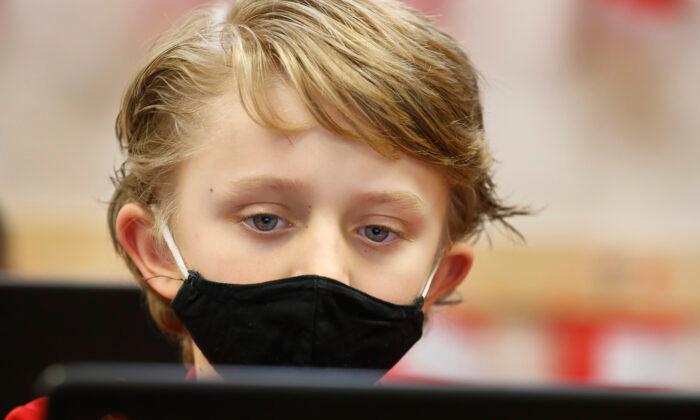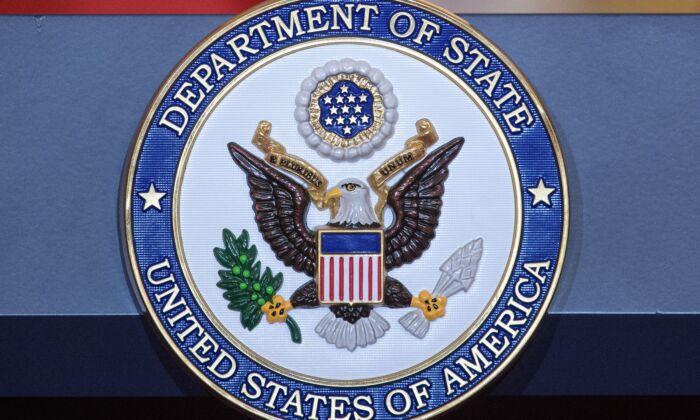New Jersey senators held a hearing last week to explore whether the science supports forcing children to wear face masks in schools amid growing concerns regarding the efficacy and negative effects of these masks.
The participating lawmakers asserted that wearing masks by children does little to prevent the spread of COVID-19 and may harm children psychologically, emotionally, developmentally, and physically.
Mask Effectiveness for Children
There have not been any randomized clinical trials on children to assess the benefits of wearing masks, but different countries responded differently to the pandemic, said Dr. Martin Kulldorff, professor of medicine at Harvard Medical School, and a biostatistician and epidemiologist.“During the first wave [of the COVID-19 pandemic] in the spring of 2020, most large Western countries closed their schools for longer or shorter time periods, including more states in the U.S. The one exception was Sweden, which kept schools and daycare open from ages 1 to 15, for which there are 1.8 million children.”
At that time, there was no mask-wearing, no social distancing, and no COVID-19 testing for children in Sweden, Kulldorf said at the hearing, but there was more cleaning than normal in schools and daycare facilities and children who got sick were sent home.
Despite this lack of restrictions, “none of these 1.8 million children died [of COVID-19],” Kulldorf emphasized.
“COVID is primarily spread through adults. When children do get infected ... they typically get it from an adult. And it’s very unusual to get transmission from children to adults.”
The risk of COVID-19 infection for teachers is the same or slightly lower than the average in other professions, Kulldorf said. “There’s no purpose of wearing masks, either for the benefit of the children or for the benefit of teachers. There’s no public health reasons to do that.”
“I think in the United States, for this whole pandemic, there have been about 350 reported COVID deaths among children. And we don’t know exactly how many of those are due to COVID versus how many are with COVID because [the] CDC hasn’t done that evaluation.”
Kulldorf said that the number of child deaths due to influenza is between 200 and 1,000 every year depending on the severity of influenza.
Adverse Effects of Masks

Due to the high intake of carbon dioxide, children sampled for the study experienced symptoms such as irritability, headache, difficulty concentrating, reluctance to go to school or kindergarten, malaise, impaired learning, drowsiness, or fatigue, Crisler said.
The issue of mask-wearing is even more critical for children than for adults because anatomical differences make a child more vulnerable than an adult to injury from oxygen deprivation and high intake of carbon dioxide, the clinical scientist explained.
“There are physiological changes within 45 seconds of wearing a mask to the brain, from the heart, the lungs, the kidneys, and the immune system.”
Moreover, microbes can concentrate on the outside of masks because microbe carrying droplets are trapped in masks and can be re-inhaled, Crisler said in her presentation. “Without a mask exhaled droplets and aerosol dry quickly. ... The longer the mask is used, the more bacteria are exhaled through it.”
“The outside of surgical mask—the ones that the children are mostly wearing to school—tested in hospitals, found more concentrated microbes on the outside of the masks themselves than in the environment.”
Crisler also mentioned that natural solutions to protect children “begin with diet and exercise,” as poor diets and lack of rest are among factors contributing to disease and immune dysfunction.
Alexander also said that cases of asymptomatic transmission of COVID-10 which drove the lockdowns and school closures as well as reinfections are very rare.
“When we look at the evidence, we can’t find clear indications, actual evidence, cases, where asymptomatic spread is a real concern or reinfections, recurrent infections is a real concern. And we can argue each case that you present as flawed interpretation.”

Jacqueline Tobacco, a member of the Board of Education in Middletown, New Jersey, testified that her son attended a school without wearing a mask since September after a long fight and a lawsuit that she had filed.
“He has successfully attended school all year—schools have been open in Middletown—and never was quarantined, never got COVID,” Tobacco sad.
She won the race for a seat on the Board of Education after campaigning on a platform against the lockdowns and against the mask mandates and became a board member in January.
Erin Pain, a school nurse, testified that wearing masks can harm children psychologically, developmentally, and physically.
She saw many children experiencing anxiety and severe fear. Pain told senators the story of a girl who came to see her because she vomited in class. That girl got really nervous when she saw people wearing masks and the thought occupied the child’s mind to the point that she felt sick in her stomach and threw up.
Another girl who Pain saw was hysterically crying because she forgot to bring her mask to school and was afraid that she would bring COVID home. “I had to spend 15 minutes with her to calm her down just to get her to go into class,” Pain said.
A child’s development may also be impacted by wearing a mask, Pain explained. “Children learn by recognizing facial cues … and [their learning] is hindered by wearing a face mask.”
When their teacher smiles at them, children know that they got the right answer or did a good job, Pain continued.
“Developmentally, these kids are suffering. They’re having a really hard time, especially the hearing impaired and the special needs children who are having a severely difficult time wearing these masks,” she said.
The nurse also saw face rashes, sore throat, canker sores related to wearing masks. Children sometimes wear the same mask for several days, touch them, and sometimes forget to wash their hands after using the bathroom, or flip them inside out, Pain said.
New Jersey state Sen. Michael Doherty, a Republican, said after all testimonies were given, “We heard today that masks cause harm and there’s no benefit. And there’s a lot of science to back that up. It’s causing irreparable harm to our children. And the science is very clear to me.”
“It was really important to hear the science,” said Republican New Jersey Sen. Kristin Corrado.





